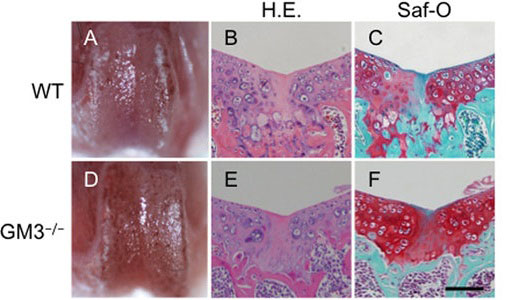ガングリオシドの欠損はマウスにおいて関節軟骨の修復を亢進する
Depletion of Gangliosides Enhances Articular Cartilage Repair in Mice
2017年3月2日 Scientific Reports 7 : 43729 doi: 10.1038/srep43729

損傷を受けた組織の治癒機構を解明することは、組織工学を飛躍的に発展させる上で非常に重要な一歩である。関節軟骨は再生医療による修復が臨床的に最も成功している組織の一つであり、その理由は細胞外マトリックスが均質で、細胞の種類が少ないためである。しかし、軟骨の修復機構についてはほとんどわかっておらず、そのため再生軟骨は本来の組織に劣る。本研究で我々は、糖鎖修飾が関節軟骨の修復過程において軟骨細胞の肥大化に重要な過程であることを明らかにした。ガングリオシドの合成経路の起点であるGM3は、損傷組織の周囲で一過性に発現し、GM3合成酵素を欠損させると軟骨の再生が促進された。またガングリオシドは、Indian hedgehog経路を介した軟骨細胞の肥大化を制御していた。これらの結果は、糖鎖修飾により制御される軟骨細胞の肥大化を介した軟骨治癒の新たな機構を明らかにするものである。ガングリオシドやその合成酵素を操作することで、関節軟骨の修復に有益な効果をもたらす可能性がある。
Corresponding Author
Elucidation of the healing mechanisms in damaged tissues is a critical step for establishing breakthroughs in tissue engineering. Articular cartilage is clinically one of the most successful tissues to be repaired with regenerative medicine because of its homogeneous extracellular matrix and few cell types. However, we only poorly understand cartilage repair mechanisms, and hence, regenerated cartilage remains inferior to the native tissues. Here, we show that glycosylation is an important process for hypertrophic differentiation during articular cartilage repair. GM3, which is a precursor molecule for most gangliosides, was transiently expressed in surrounding damaged tissue, and depletion of GM3 synthase enhanced cartilage repair. Gangliosides also regulated chondrocyte hypertrophy via the Indian hedgehog pathway. These results identify a novel mechanism of cartilage healing through chondrocyte hypertrophy that is regulated by glycosylation. Manipulation of gangliosides and their synthases may have beneficial effects on articular cartilage repair.

